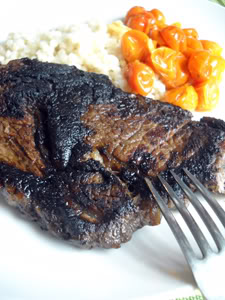
Whoa. That is some good bison. The ribeyes, I mean—holy cow. Tender does not begin to describe it.
Pretty much as soon as I unpacked the box last week, I knew the ribeyes would be that night’s dinner—I plunked the pair of vacuum-packed beauties into a pot of cold water for a fast defrost, and whipped up a quicker-than-quick marinade: balsamic, a bit of oil, a generous bunch of herbs, and garlic. Ain’t nothing simpler, baby. The meat soaked up the flavors for about two hours, and then it hit the cast-iron pan. Bison cooks quickly, quicker than beef, so it took some serious hoop-jumping to ensure everything was ready simultaneously; I tossed some sun-gold tomatoes into a blazing-hot oven with sliced garlic and a little oil, then threw together an Israeli couscous pilaf, all before I put the pan on to preheat.
In the end, the meat was the tiniest bit overcooked (but honestly, I’m a medium-well kinda gal anyway, so I was happy) and it was still amazing. Stephen said it was the best steak I’ve ever cooked. Granted, I don’t cook a ton of steak, but still: best. ever.
Harry, of course, refused to taste it. “I don’t really like bison.” Oh really, kiddo? Are they serving bison at your preschool now? Cuz I sure haven’t served this before. Not to mention those bison burgers you devour regularly. Sigh. He had couscous (which we call “macaroni balls” since he insists he doesn’t like couscous either, and which he sorted carefully, pulling aside and refusing to eat any individual balls that were too browned for him) and a yogurt. Yum.
Two things to note: First, even though bison meat itself is extremely lean, there was a considerable amount of fat surrounding the pieces. Those two steaks, which were 9 ounces each raw, gave us about 12 ounces of cooked meat in total. Twelve ounces of seriously tasty meat. And second, this marinade doesn’t have to be used on bison. The flavors will work equally well with beef. Since I know we don’t all have FedEx men dropping off unsolicited boxes of bison…
Balsamic-Herb Bison Steak
Serves 2 to 4
Weight Watchers: a 4-ounce serving is 5 points. I don’t count the oil in the marinade since so little of it penetrates, but I do count the oil in the frying pan.
1 tablespoon olive oil, plus more for the pan
2 tablespoons balsamic vinegar
1/4 cup mixed herbs (I used parsley, mint, and thyme)
4 garlic cloves, smashed
pepper
1 to 2 pounds bison steak (I used ribeyes, courtesy of High Plains Bison)
salt
- If you have a mini-food processor, put the olive oil, balsamic, herbs, garlic, and pepper into the bowl. Process until the herbs and garlic are finely chopped, and transfer to a nonreactive bowl large enough to hold the steak. If you don’t have a mini-food processor, grab yourself a big ol’ knife and get chopping. The smaller the pieces, the better. Once everything’s chopped, put it in that nonreactive bowl I mentioned, and whisk in the oil, vinegar, and pepper.
- Dunk one side of the steak into the bowl, then flip it over and leave it there—this doesn’t make a ton of marinade, but don’t worry, it’s enough to penetrate. Cover and refrigerate for at least two hours and up to overnight.
- About 30 minutes before you want to eat, remove the steak from the fridge and put a large cast-iron pan over medium heat. While it’s heating up, pull the steak from the marinade and pat it dry—wipe off any large bits of herb or garlic, since they burn easily. Sprinkle both sides liberally with salt.
- When the pan’s smoking, drizzle a teaspoon or two of olive oil into it and add the steak, laying it in carefully so you don’t get splattered.
- Cook for 5-7 minutes on one side, then flip and cook for another 5-7 minutes. Be careful not to overcook it—bison cooks faster than beef. For tips, check out High Plains Bison’s advice.
- Remove the steak to a plate, cover loosely with foil, and let it rest 10-15 minutes before serving.
